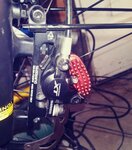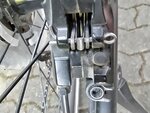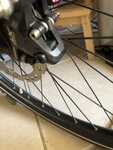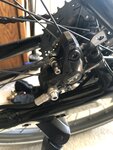Sierratim
Well-Known Member
- Region
- USA
- City
- Nevada City, CA & Paradise Valley, AZ
How many miles are you getting on a set of pads? What brand and type of pads?
I've never owned a disc brake equipped bike before my Vado 5 though I have worked on a few with my sons and at the local 'bicycle kitchen'. Nice stopping power, but my pads wear much faster than I'd expected. I got ~500 miles on the first set of pads with the front pads wearing noticeably fatser than the rear. I suppose I was accostomed to the life I get out of the V-brake pads on our mechs. Lighter bikes on more level ground are apparently not good standards to set expectations for disc pads!
Our Vados are equipped with Shimano BR-M8000 calipers and SM-RT76 series rotors. Shimano G03 'organic' pads were originally installed as I recall.
At my sons'suggestion I switched to Shimano metallic/sinthered pads, J04C. The goals were even better stopping power and much longer pad life. I struggled to get them to quit squealing and as I've said in at lesst one other post, noisy brakes suck. I 'bedded' them in (see https://reviews.mtbr.com/how-to-bedding-in-new-disc-brake-pads and
), cleaned rotors and pads several times, lightly sanded the pad surfaces, and even tried the Squeal Out abrasive compound. Nothing really helped, except Squeal Out, but it only worked for a few miles. After reapplying it several times, I gave up after ~60 miles of trying and went back to organic pads, more G03s. Quite brakes rematerialized instantlly.
The 2nd set of organic pads were wearing just as fast as the first set. One theory I read was that since the organic pads don't conduct heat to the rotors well their wear might be accelerated by heat build up caused by braking on our local hills - my typical ride inclides 2,000 - 3,500 feet of climbing. After several hundred more miles of quite braking (and maybe 50% pad wear) I decided to try organic pads with integrated heat sinks. Shimano makes these as well, J03 pads, but I decided to try another brand, KOOL STOP Aero Kool KS-D635K pads.

So far, so good. The brakes aren't quite as quiet (did I get the 'e's in all the right spots?). KOOL STOP does claim longer life so maybe the pads are harder. They seem to have the same stopping power as the original Shimano pads. Time will tell if the heat sink improves pad life. I'll report back.
How are your brakes doing?
I've never owned a disc brake equipped bike before my Vado 5 though I have worked on a few with my sons and at the local 'bicycle kitchen'. Nice stopping power, but my pads wear much faster than I'd expected. I got ~500 miles on the first set of pads with the front pads wearing noticeably fatser than the rear. I suppose I was accostomed to the life I get out of the V-brake pads on our mechs. Lighter bikes on more level ground are apparently not good standards to set expectations for disc pads!
Our Vados are equipped with Shimano BR-M8000 calipers and SM-RT76 series rotors. Shimano G03 'organic' pads were originally installed as I recall.
At my sons'suggestion I switched to Shimano metallic/sinthered pads, J04C. The goals were even better stopping power and much longer pad life. I struggled to get them to quit squealing and as I've said in at lesst one other post, noisy brakes suck. I 'bedded' them in (see https://reviews.mtbr.com/how-to-bedding-in-new-disc-brake-pads and
The 2nd set of organic pads were wearing just as fast as the first set. One theory I read was that since the organic pads don't conduct heat to the rotors well their wear might be accelerated by heat build up caused by braking on our local hills - my typical ride inclides 2,000 - 3,500 feet of climbing. After several hundred more miles of quite braking (and maybe 50% pad wear) I decided to try organic pads with integrated heat sinks. Shimano makes these as well, J03 pads, but I decided to try another brand, KOOL STOP Aero Kool KS-D635K pads.
So far, so good. The brakes aren't quite as quiet (did I get the 'e's in all the right spots?). KOOL STOP does claim longer life so maybe the pads are harder. They seem to have the same stopping power as the original Shimano pads. Time will tell if the heat sink improves pad life. I'll report back.
How are your brakes doing?






